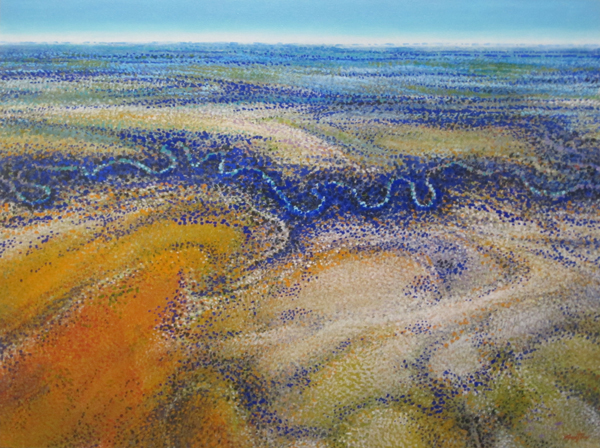
Flood Plains, Darling River
Flood Plains, Darling River 92 x 152cm Acrylics on Stretched Canvas
Graham Austin OAM
Briefly, I paint in spots [a pointillist style] searching to capture the
spirit of the aerial landscape, whilst capturing a cartographic expression of spotted abstraction.
Some of my works include an horizon line and a sense of perspective.
My painting style has been influenced from my first flight, seven years old.
The remembered images were astounding.
Trees and rocks looked like spots. The rolling surf, like cotton wool, rolled and extended.
A very primitive image that remained embedded in my mind, tangled in youthful exuberance.
I revisit that experience with paint, coupled with the added sophistication of capturing the sense
of spirit emanating from landscape patterns, conjointly, exuding from the spirit.
The abstracted creation of landscape, water and wind carved design, sculpted moving surfaces,
interpreted from a primitive vision of a seven year old self.
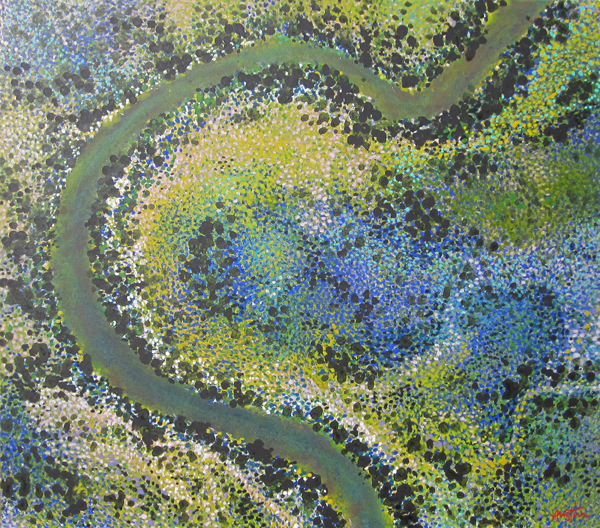
'Meandering' Acrylic on Canvas 92 x 102cm
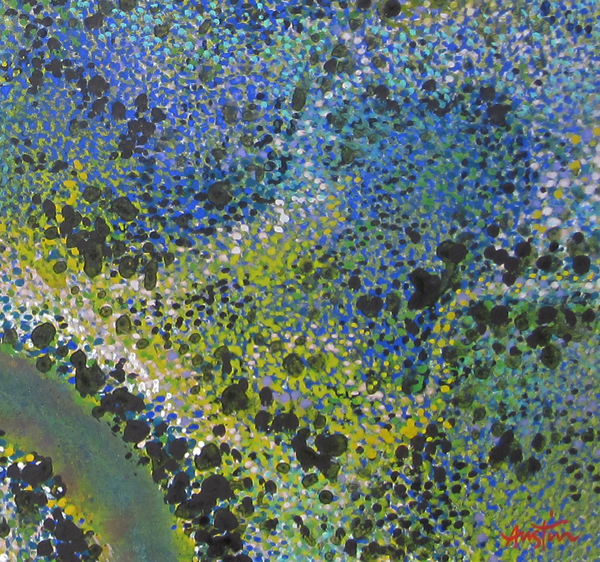
'Meandering' [Detail]
Initially, I was trained with traditional values and an appreciation for the
importance of good drawing as the foundation structure.
Close up, much of my work appears as spotted abstraction, from a distance the fusion of colour and shapes unveil
the solid drawing structure hidden beneath the abstraction.
My website shows work available for purchase and mainly unseen recent pieces.
No works produced prior to 1988 are reproduced on this website. There are variations in style representing trends in development.
I have, however, been painting in my spotillist style since 1972. Although, for about three or four years,
encompassing my painting expeditions in the Kimberley, I discarded the spotillist approach,
which was quite an extraordinary decision because the Kimberley seems to have a
spotted texture of its own, and because of its harshness,
I believe it particularly lends itself to my style.
I have generally returned to my spotted technique painting acrylics and
watercolour to express the sense of spirituality I glean from the great outback.
I see the Australian landscape as a rugged sculpture, enhanced with a strong sense of spirituality and
swathed in a harsh, varying light that generates its own visual poetry, at times drama.
I like to paint that poetry of visual repetition and monotony where you have to take time out, smelling it,
studying its perspective and feeling the vast aura of its natural presence.
The Australian landscape tells me it is holy ground, akin to an open air cathedral and
out there I feel the presence of God's omnipotence.
The Beginning
I first became interested in art and becoming an artist at a very early age.
The oldest report goes back to when I was in a cot, crying.
My grandfather told me he said to my mother, “Give him a pencil and paper, that always shuts them up”.
He claimed I drew the joining of two walls and the ceiling plus the light hanging from the ceiling.
That was his story and I am sticking with it.
At school I was always drawing. Classmates were always asking me to draw in their books for them, or they would want to copy my drawings.
When I was attending high school my father said, “If you go well in your school work I wíll send you to art classes, if not it will be coaching college”.
I was destined to coaching college where I fascinated the tutors with drawings and cartoons which they always confiscated.
Somehow they taught me algebra and trigonometry, and consequently, passed my exams then, promptly forgot those subjects on leaving school.
Drawing has always been an important element in my painting because it was my drawing skills as a child that had others declaring me as an artist.
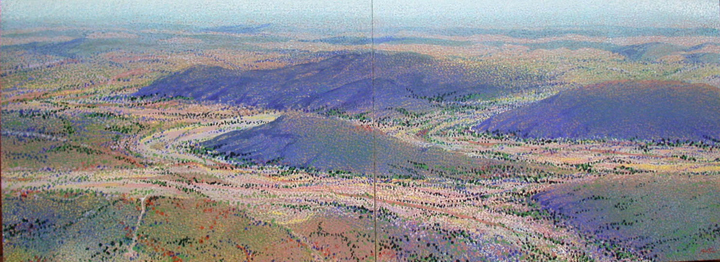
Western Vista
Acrylics diptych on 152 x 61cms Stretched Canvas
SOLD
My work has been subconsciously influenced from my first time in the air.
It was a seaplane joy flight whilst on holidays down the south coast of NSW as a seven year old. The remembered images were quite astounding.
I saw the landscape made up with spots, dots and dashes. Rolling surf looked like cotton wool rolled into stringy strips.
Trees were spots, there was a sense of primitive design to the landscape.
I was caught up in the youthful exuberance of taking off from a small lake, experiencing the giddy excitement of a first time adventure in the air,
absorbed in wonderment and then thrilled with the pilot’s skill in landing the craft back onto the small lake.
On one of his flights we witnessed a misjudgement where the pilot overshot the lake whilst landing and slid from the water up onto the sand.
Unsurpassed excitement for me as a child but also with a sense of relief it didn’t happen on my flight.
In later years, driving around Oberon in the Blue Mountains and looking down into the valley, my childhood flight experience was rekindled.
I started painting elevated views. I discovered working from photographs was generally quite inhibiting.
The camera doesn’t capture the soul of the landscape and it ignores that emanating spirit whereas, memory and imagination does.
That same spirit emerges from your work when you paint according to the logic of the landscape and in particular, your emotional feel of the landscape’s creation.
I feel I have to understand how the ground surface is washed and blown by nature, creating the earth’s wrinkles and suggesting its subjective, emotional response.
In my case, by incorporating a gallimaufry of spots with a sense of organised chaos.
Oddly enough, when spots are not placed in the right places the picture looks incredibly wrong, the rules of perspective cannot be ignored.
The main influences on me as an artist now are the marvellous effects of aerial landscape and
the sense of spirit emanating from the landscape patterns, that conjointly, emanates from the spirit.
I paint in spots, in a style akin to the pointillists but I am more interested in creating a
spotted abstraction on close inspection, that fuses into reality when viewed from a distance.
The main themes and subjects of my artworks are mostly the abstracted
creation of landscape where water and wind carve the design, sculpting the moving surface.
I like the sense of rocks and trees becoming spots, sometimes standing alone and sometimes gathering in groups just like people,
intermingling in life and becoming a tide of movement, a current of aerially viewed patterns juxtaposed in perspective.
My process of determining stages of development when creating an artwork are mostly cerebral,
working directly from my brain straight to the painting surface.
I rarely do preliminary sketches. I like to visualise the subject in my mind, then paint direct.
I remain flexible with the original idea, grabbing at any possible opportunity created by mistakes.
This mode of operation or approach was developed from the fluidity involved when working in watercolour.
When I am exhibiting my work I feel the real opportunity to compare my painting against others.
I can assess my feelings, the sense of landscape spirit and perception of quality.
I have no problem with personal exposure of my work.
I naturally enjoy adulation and usually weigh up negative and/or critical response
after my own self assessment and follow my own beliefs
My work routine is constant, whether on the painting surface or in my head.
The most frustrating times are when caught in a famine for ideas or energy lapse.
The old saying, ideas can come in the shower is true.
It doesn’t matter where you are when the ideas come as long as they are there.
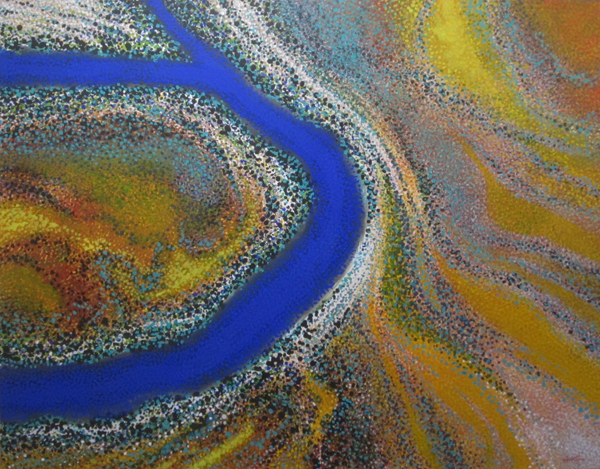
Dancing Flood Plain
Acrylic 122 x 152cms on Stretched Canvas
I have camped out in the Kimberley on three occasions, three weeks at a time.
There the landscape seems to be more consciously a sea of spots and
has therefore made an indelible impression on me.
The Kimberley also has a greater sense of spirituality than many other places.
Whether it is aboriginal spirit released from the landscape or vice versa I do not know.
What I do know is I was in one of the greatest cathedrals in the world,
never alone, almost living in another dimension.
Most of my influences have emerged from the harsh Australian landscape.
I have been to Fiji, England, Italy, France, Singapore and Bali but
none feel to me like the Australian landscape spirit.
The symbols of landscape, or painters’ marks
representing landscape objects is always worth observing.
Some artists don’t particularly use any symbols.
My preference is using abstract marks, spots and shapes
that combined, form the whole.
Do I paint like anyone else?
When one of my very early paintings was mistaken for the work of a tutor, I was mortified.
I started questioning the origins of technique and decided I wasn't going to paint like anyone else again.
I now talk about the quest that led me to the discovery of the process I call "landscapes determined by fate".
Do I really paint like anyone else?
I confronted myself with this question early in my career,
whilst a student at the National Art School, East Sydney Technical College.
It seemed I had a natural affinity with watercolour and acrylics.
I was particularly impressed with the talent of one of my tutors at that time.
During a session of constructive criticism my eyes were opened to "signature style", that is, a style recognisably one's own.
The prominent artist conducting the constructive criticism left
my painting until last and then said "Well Brian, I don't know how you do it".
He thought my work was painted by another artist he respected and gushed with praise and admiration.
Up until then, it had been the best painting I had ever done and I was proud of it.
Brian announced it was not his work but that of one of his students, pointing to me.
The gushing praise was then directed to me for simply learning the lessons well.
In another sense, I was an imitator not an inspirator. I was painting my versions of his style.
I was embarrassed. but also aware of the quotation, "99% of most art is imitation, 1% is innovation".
I didn't even feel that my subconscience imitation of Brian's style
was as good as his, even though it did bear a resemblance.
I had obviously been influenced by his work,
his problem-solving approach, technique and style.
As everyone present on that occasion patted me on the back, adding to the praise,
I was thinking, "How am I going to solve painting problems my way?" and,
"How can I make my paintings look like they were painted by me? “
Change was going to be tough because that painting
also won me my second art prize. That was 1964.
I said to myself, now is the time to paint like me but unfortunately,
I didn’t know how to paint like me. I didn’t know what a Graham Austin painting should look like.
I realised though, it was something I had to develop.
Graham Austin’s Shock of the
New
At that time I was painting traditional landscapes.
The following weekend I headed bush, sat in the middle of a dry creek bed, confronted by a subject I was willing to attempt.
I decided my approach to the subject was going to be different from the style to which I was accustomed.
Before this fateful day I would spend hours drawing and observing. Carefully, I would mentally note details, the change of light and mood.
I would then spend several months digesting all this information in my mind, thinking my way through the painting, not even lifting a brush.
Then, with my energies in place I would pluck up the courage to add colour and tone to bring the drawing to life. I guess it was like colouring in.
That approach obviously worked however, this time I was not going to spend hours drawing with a pencil.
In the middle of this dry creek bed, I attacked my virginal white paper with
washes of colour and tone, quickly trying to capture the subject
and mood without any pencil drawing or lengthy period of observation involved.
I worked directly with richly stained water and watercolour brush, not a hint of pencil outline.
I had taken the first step to paint like Graham Austin.
I also discovered that painting is drawing and drawing is painting. Good painting relies on good drawing skills.
I had taken my first bold step in a new direction but I still had a long way to go.
Even today, I feel I haven't progressed to my final destination.
I have no idea where it will be but I will not fall into the trap of following fashionable trends.
My dry creek bed painting gave me some encouragement because it earned me a
Highly Commended. Not first prize but, more importantly, I liked what I had done.
I always feel art prizes are like lotteries, for no other reason than subjectivity.
You can't be all things to all judges, but art prizes are
nice to win, it says one of my peers liked my work.
Expressing individuality

Cartographic Creek
76 x 153cm Acrylic on Stretched Canvas
I never kept a record of the dry creek bed painting and my memory tells me
it was probably not too different in style to any other traditional painting I had done before.
The journey, however, was shorter.
My observation skills had quickened and retrospectively I can
see I had begun to search for my own style.
The fact that nobody else paints like me or, more particularly,
I don't paint like anyone else delights me.
It means I am expressing my individuality.
Whether others like my work or not doesn't matter either.
It is nice if they do and very
flattering, but I emphasise the point, I am painting in my own style which,
incidentally, keeps evolving because of life's various influences.
This suggests to me I am reflecting life's hiccups
and flows through my painting style.
Finding the perfect tool
Another turning point for my painting style and individuality
came from that often considered and repeated tip,
"Use a larger brush than you really think necessary because it will stop you from fiddling".
I discovered a stippling brush with the brush area measuring approximately 20 x 15cm that
allows me to dab at the work creating stippled spots.
Changing the angle of the brush generates wonderful textures,
changing colours offers extraordinary visual effects.
Although I originally trained as a traditional painter I have ventured off into
total abstraction and returned to subject matter, backwards and forward,
at various times of total abstraction, producing works I felt were visual interpretations of music.
For many years I have enjoyed the abstracted rhythms and patterns of aerial landscape.
I became fascinated by the design and patterns before me.
A spotting technique suited my direction, subconsciously embedded as a
seven year old during a seaplane joy flight. I saw the landscape made up with spots, dots and dashes.
I began to think of the surrounding atmosphere, with or without mist, being made up with spots and dots.
I began to think of everything and everyone being made up with atoms.
It is here I must mention my beginnings, I was adopted. My original birth certificate states my birth mother’s name.
My father’s name was omitted, just a diagonal line. I have searched unsuccessfully for information and
wondered if I had aboriginal blood because of my empathy and admiration for their culture.
Whether I have a percentage of aboriginal background or not doesn’t matter, either way is good.
Time has intervened, I found my birth family. My mother and two younger brothers are deceased.
An Aunt strongly felt, by being reminded by my body language, that it echoed another sister's past husband,
suggesting my birth uncle was actually my father. No science, just gut feeling.
Accepting her gut feeling I refer to him as my 'Uncle Dad'. I have since had my dna tested I have no aboriginal dna as such.
My dna reading indicated Viking, Scottish, Turkish, Iranian and Greek.
I like to think that long before aboriginal culture and painting was fashionable
I was seeing Australian landscape with their influence, of landscape having spirit and that spirit strangely being landscape.

Outback Vista
76 x 102cm Watercolour on Mounted Watercolour Paper
I see the Australian landscape as hard, harsh and unforgiving, not necessarily always poetic.
I fully appreciate the aboriginal use of spots while admiring the values of western art.
Sometimes my work is interpreted as a mix of both.
It has also been mused that I step in each value, which may suggest there are variations.
I enjoy the visual fusion of complimentary and tertiary coloured spots fusing to make new colours and forming abstracted spaces.
The more abstracted my work is the more it is strangely recognisable, therefor the more I feel I have been successful.
I don't necessarily use the stippling effect for all spotted marks. I often use any favourite old brush that will make spots.
I also use a flat brush for laying down some overall washes or painted shapes, particularly in my watercolours.
Sometimes I use wet, juicy, flowing colour that generates worries for me as the picture dries.
At other times I limit the amount of juice or even work a combination of sloshy, wash spots.
Usually I have a firm idea of what I am going to paint but at times I don't, relying on the feeling of
landscape and leaving destiny to imagination, chance and search in the early stages of a picture.
Often the weather can influence the end result of a painting because of fast or slow drying. It is all part of the exciting challenge.
The real magic I believe, is when the right side of the brain has total command.
That is when I can reach into my subconscious mind with a grasped idea and channel energy through my heart.
From there the energy is extended spontaneously along my arm, off the brush onto the paper or canvas under a watchful eye.
This may all sound rather romantic or
far-fetched. Unexpectedly, when the brain, the hand and the elements
work together in harmony, unison results and the effort most rewarding.
When I am in the right side of my brain there seems to be a oneness, reflecting a loss of
awareness to logic per se but the subject naturally falls into place, somehow.
On other occasions, resolving a painting is nothing but struggle and hard work.
Making Watercolour Magic
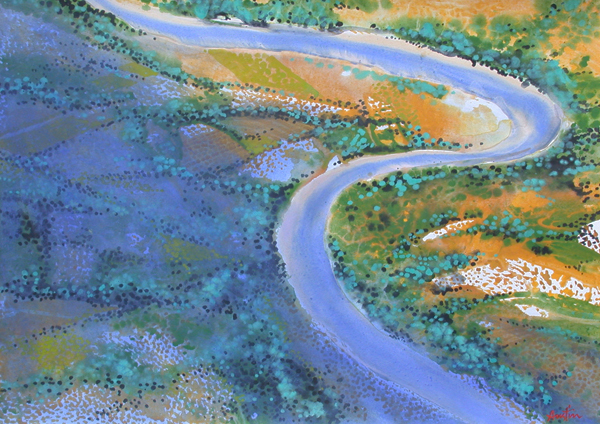
Afternoon Shadowing
Watercolour 76 x 102cms on Mounted Watercolour Paper
When I start painting a watercolour I begin with a wet sponge of
clean or tinted water and I drag it across the paper leaving transparent landscape marks,
This is the beginning of drawing.
I leave the sky area dry. If there is to be a significant landscape shape like a mountain,
I draw it as a wet mass with the sponge of water.
Now comes the exciting part when I introduce the fat stippling brush loaded with colour.
Adrenalin is rushing and I feel like a magician as colour touches the wet paper and runs.
The painting starts to take form and it is all immediate as the initial wash appears.
Good things and problems appear simultaneously. It is all very exciting as colour creeps into
wet sections and the picture keeps changing. The wet edge moves like a mini flood.
I try to resist the urge to fiddle but attempt to end major disasters.
No matter what, I generally consider the first wash my first mistake and a suggestion of the end result.
Hopefully, It is time to make corrections, enhance the good effects and
convert this free, sloppy wash into a recognisable land form.
My painting approach is is something of a parallel to
what happens when nature creates the real thing.
Every rainfall is a sloppy wash, shifting and shaping the landscape, creating ridges and rivulets.
I have to have faith in my own talent, remain flexible in my thinking,
taking advantage of natural mistakes and turn them into opportunities.
I have to make magic, use my imagination while searching for the landscape in my
creation. I rather like one of the late Lloyd Rees' comments when he said,
"I have to confess that I simply do not care how a picture is produced - it is the result that matters".
I therefore prefer to have the subject taking control, not the technique.
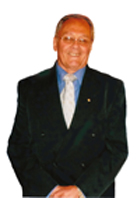
About The Artist, briefly
Graham P Austin was born in 1941. He studied at the National Art School, East
Sydney from 1957 to 1961.
He became a member of the Australian Watercolour
Institute (AWI), in 1972 and was President from 1989. to 2003.
During this
time he was made a Life Member.
He was President of the Peninsula Art Society
from 1986 to 1988, and
Foundation Senior Vice President/President of the Drummoyne
Art Society from 1964 to 1967.
Graham has held several solo exhibitions and participated in many group exhibitions
both here and overseas,
including New Zealand, Mexico, UK, Spain, , Japan,
Canada, Korea and Hong Kong.
He has made study tours to the Kimberley and
the
Northern Territory, Fiji, Bali, UK, France, Italy and Singapore.
He has won over 35 major awards and received many commendations.
His work
is represented in many collections including
Manly Art Gallery, Lismore Art
Trust; Drummoyne, Ryde, Waverley and
Pittwater Councils, Montrose Wines, Tooheys,
Tomago Aluminium,
Trinity Grammar, Scotts College, Kincoppal College, The
Prince of Wales Hospital Randwick,
Elcom Credit Union, International Museo
de la Acuarela Mexicana, and
many private collections in NSW, Queensland,
Victoria and Western Australia.
Also UK, USA, Hong Kong, Singapore, Malaysia,
Netherlands and Japan.
Graham P Austin welcomes you to browse his original, contemporary online art gallery.
Acrylics, Oils and Watercolour
Graham Austin OAM Australian Fine Artist:
Acrylics,
Oils and Watercolour Paintings
Australian Fine Artist in Acrylics, Oils and Watercolour
Awarded Order of Australia Medal [OAM] 2006
Australian Watercolour Institute [AWI], Emeritus President
Member of Australian Watercolour Institute (AWI), since 1972.
AWI President from 1989 to 2003.
AWI Honorary Life Member since 1997.
President of Peninsula Art Society from 1986 to 1989.
Foundation President/ Senior Vice President of Drummoyne Art Society 1964 to 1967.
Visit: YouTube, Colour In Your Life, Graham Austin
Other Website
Links of Interest:
Australian
Watercolour Institute www.awi.com.au
Artsite Gallery www.artsite.com.au
KAB Gallery, Terrigal www.kabgallery.com.au
Greenhill
Galleries Adelaide www.greenhillgalleriesadelaide.com.au
Electronic
Cottage Art & Craft Gallery www.electroniccottage.com
Juried
Online Art Festival www.jolaf.com
Indigo
Art www.indigoart.com.au
Brian
Dunlop www.briandunlop.com
John
Caldwell www.waragilstudios.com.au
Bernd
Heinrich www.berndheinrich.com
Roger
Murphy www.rogermurphy.com.au
Guy
Troughton www.guytroughton.com
Robert
Wade www.ozemail.com.au/~rawadw
Wendy
Bookatz www.wendybookatz.com
Saatchi-gallery www.saatchi-gallery.co.uk/
Artarmon
Art Gallery www.artarmongalleries.com.au
Christchurch
Art Gallery New Zealand www.christchurchartgallery.org.nz
Gosford Art Gallery www.gosfordregionalgallery.com
HotFrog
Australian Business Directory www.hotfrog.com.au
Wagner
Art Gallery www.wagnerartgallery.com.au
David Rex-Livingston Art Dealer www.rex-livingston.com
Galeria Aniela Fine Art Gallery www.galeriaaniela.com.au
Royal Art Society www.royalart.com.au
Royal Scottish Society of Painters in Watercolour www.rsw.org.uk/
Royal Watercolour Society www.royalwatercoloursociety.co.uk/
Saatchi Gallery Britain www.saatchi-gallery.co.uk
Ulster Watercolour Society www.uws.org.uk
Thank you for visiting
Graham Austin's website gallery,
I hope you like what you see.









